
Pennsylvania Station is the main intercity railroad station in New York City and the busiest transportation facility in the Western Hemisphere, serving more than 600,000 passengers per weekday as of 2019. The station is located beneath Madison Square Garden in the block bounded by Seventh and Eighth Avenues and 31st and 33rd Streets and in the James A. Farley Building, with additional exits to nearby streets, in Midtown Manhattan. It is close to several popular Manhattan locations, including Herald Square, the Empire State Building, Koreatown, and Macy's Herald Square.

Metro-North Railroad, trading as MTA Metro-North Railroad, is a suburban commuter rail service operated by the Metropolitan Transportation Authority (MTA), a public authority of the U.S. state of New York. Metro-North serves the New York Metropolitan Area, running service between New York City and its northern suburbs in New York and Connecticut, including Port Jervis, Spring Valley, Poughkeepsie, Yonkers, New Rochelle, Mount Vernon, White Plains, Southeast and Wassaic in New York and Stamford, New Canaan, Danbury, Bridgeport, Waterbury, and New Haven in Connecticut. Service in Connecticut is operated under contract with the Connecticut Department of Transportation. Metro-North also provides local rail service within the New York City boroughs of Manhattan and the Bronx.

The Erie Lackawanna Railway, known as the Erie Lackawanna Railroad until 1968, was formed from the 1960 merger of the Erie Railroad and the Delaware, Lackawanna & Western Railroad. The official motto of the line was "The Friendly Service Route".
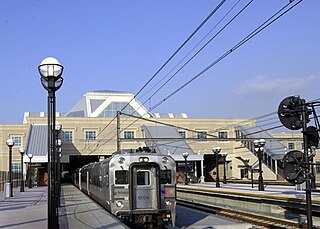
Secaucus Junction is an intermodal transit hub served by New Jersey Transit and Metro-North Railroad in Secaucus, New Jersey. It is one of the busiest railway stations in North America.
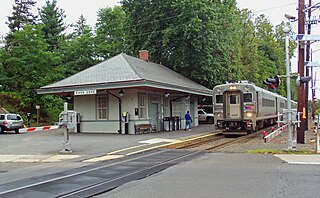
The Pascack Valley Line is a commuter rail line operated by the Hoboken Division of New Jersey Transit, in the U.S. states of New Jersey and New York. The line runs north from Hoboken Terminal, through Hudson and Bergen counties in New Jersey, and into Rockland County, New York, terminating at Spring Valley. Service within New York is operated under contract with Metro-North Railroad. The line is named for the Pascack Valley region that it passes through in northern Bergen County. The line parallels the Pascack Brook for some distance. The line is colored purple on system maps, and its symbol is a pine tree.

The Main Line is a commuter rail line owned and operated by New Jersey Transit running from Suffern, New York to Hoboken, New Jersey, in the United States. It runs daily commuter service and was once the north–south main line of the Erie Railroad. It is colored yellow on NJ Transit system maps, and its symbol is a water wheel.

Newark Penn Station is an intermodal passenger station in Newark, New Jersey. One of the New York metropolitan area's major transportation hubs, Newark Penn Station is served by multiple rail and bus carriers, making it the seventh busiest rail station in the United States, and the fourth busiest in the New York City metropolitan area.

NJ Transit Rail Operations is the rail division of NJ Transit. It operates commuter rail service in New Jersey, with most service centered on transportation to and from New York City, Hoboken, and Newark. NJ Transit also operates rail service in Orange and Rockland counties in New York under contract to Metro-North Railroad. The commuter rail lines saw 57,179,000 riders in 2023, making it the third-busiest commuter railroad in North America and the longest commuter rail system in North America by route length.
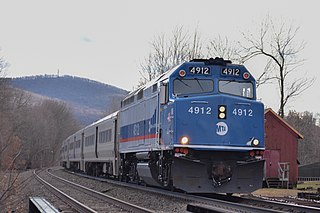
The Port Jervis Line is a predominantly single-track commuter rail line running between Suffern and Port Jervis, in the U.S. state of New York. At Suffern, the line continues south into New Jersey on NJ Transit's Main Line. The line is operated by NJ Transit Rail Operations under a contract with Metro-North Railroad (MNRR).

The U34CH is a 3,600 hp (2,700 kW) passenger diesel locomotive built by General Electric between 1970 and 1973. In total, 33 U34CH units were built; 32 were built for the New Jersey Department of Transportation and operated by the Erie Lackawanna Railway and, later, Conrail, with the last unit coming as a later rebuild of a GE U30C for the New York MTA.
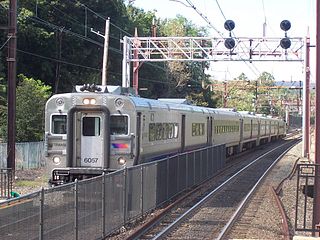
The Comet railcar is a class of locomotive-hauled railcars that was first designed in the late 1960s by Pullman-Standard as a modern commuter car for North American rail lines. Later, the Comet moniker was adopted by NJ Transit for all of its non-powered single level commuter coaches. Additional series of cars bearing the Comet name, based on the original design, have since been built by Bombardier Transportation and Alstom. The successful design was adopted by numerous commuter agencies.

Salisbury Mills–Cornwall station is a commuter rail stop served by NJ Transit and Metro-North Railroad trains on the Port Jervis Line, located in the Beaver Dam Lake section of the town of Cornwall, New York. The station is located at the northern end of the Moodna Viaduct, accessible from NY 94. Parking fees are charged on weekdays, with both permit and metered spaces available. Salisbury Mills–Cornwall station contains a large parking lot, lighting, elongated canopy and a mini high-level platform for wheelchair access to trains.

Campbell Hall station is a commuter rail stop served by NJ Transit and Metro-North Railroad trains on the Port Jervis Line, located just south of the hamlet of Campbell Hall, New York in the town of Hamptonburgh. The station is located at the end of Watkins Road, off Egbertson Road. The station contains decorative lights, a long platform roof and an elevated mini-high platform at the east end of the station for access by riders in wheelchairs. Parking is on a permit/meter system.

Middletown–Town of Wallkill station, often just referred to as the Middletown station, is a stop served by NJ Transit and Metro-North Railroad trains on the Port Jervis Line in the town of Wallkill, New York. The station is located in the latter municipality along the former Erie Railroad Graham Line. Two trains end at the station on weekdays, with one of them turning back for service to Hoboken. The station contains a mini-high platform for access by passengers in wheelchairs, and expanded paid parking. In a switch from the other stations to receive these amenities, the platform roof at Middletown is green rather than red, platform light poles are brown instead of green and the wheelchair platform is not under the roof. While other Metro-North stations such as Cortlandt and Southeast are named after the towns in which they are located, the station is the only one to include "Town of ..." in its official name, to avoid longstanding confusion with the nearby hamlet in Ulster County.

Harriman station is a commuter rail stop served by NJ Transit and Metro-North Railroad trains on the Port Jervis Line, serving the village of Harriman, New York, the town and village of Monroe, and the town of Woodbury in Orange County, New York. Before its use as a station, the area was better known as "Newburgh Junction" and was where the Erie Railroad's mainline separated from the Newburgh Shortcut. This junction was controlled by "NJ" interlocking tower and, while the mainline has been abandoned since 1983, the wye remains intact.
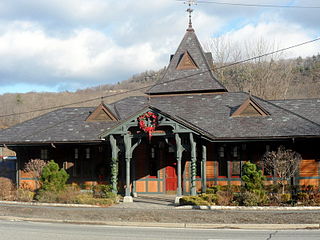
Tuxedo station is a stop served by NJ Transit and Metro-North Railroad trains on the Port Jervis Line, located in the town of Tuxedo, New York, with commuter rail to Hoboken and its connections to New York City.

Otisville station is a commuter rail stop served by NJ Transit and Metro-North Railroad trains on the Port Jervis Line, serving the village of Otisville, New York along with the town of Mount Hope. It is located a short distance off New York State Route 211 near the eastern village line. The station has long been among the least developed on the Metro-North system, with a shelter on the bare concrete low-level platform but no roof, and a 104-space parking lot across the street. A short distance west of the station, trains enter the 5,314-foot (1,620 m) long Otisville Tunnel under the Shawangunk Ridge, the longest in the Metro-North system and one of only two outside of the city. There is a long siding beginning just west of the station that allows trains to wait if one is coming through the tunnel. As a result, Otisville is technically a double-tracked station. When trains coming from the other direction are approaching, passengers board on the siding via a wooden platform on the tracks.

Sloatsburg station is a commuter rail stop served by NJ Transit and Metro-North Railroad trains on the Port Jervis Line, located in the village of Sloatsburg, New York at the intersection of Municipal Plaza and Mills Street.

Paterson is a New Jersey Transit commuter railway station located on an elevated viaduct above Market Street in downtown Paterson, New Jersey. The railway through the station is double tracked, for north and south traffic on the NJT Main Line.




















